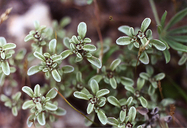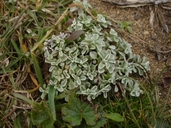Taxon Details
Hesperevax sparsiflora var. brevifolia
short-leaved evax
View Report Copy Link Calflora eFlora CCH CalPhotos iNaturalist
Taxon Summary:
Hesperevax sparsiflora var. brevifolia, commonly known as short-leaved evax, is a annual herb in the Asteraceae that is found in California and elsewhere. It occurs within Coastal bluff scrub (sandy), Coastal dunes, and Coastal prairie, growing at elevations from 0 to 215 meters. Hesperevax sparsiflora var. brevifolia is ranked 1B.2, Plants Rare, Threatened or Endangered in California and Elsewhere; Moderately threatened in California.|
Scientific Name: Hesperevax sparsiflora (Gray) Greene var. brevifolia (Gray) Morefield |
||
|
Common Name: short-leaved evax |
||
| Family: | Asteraceae | |
| Element Code: | PDASTE5011 | |
| USDA Plants Symbol: | HESPB | |
|
Synonyms/Other Names: |
||
| Name Status: |
JEF, FNA, POWO, IPNI, Tropicos |
|
| CA Rare Plant Rank: | 1B.2 |
| Fed List: | None |
| State List: | None |
| Global Rank: | G4T3 |
|
State Rank: |
S3 |
| Other Status: | BLM_S; SB_CalBG/RSABG |
|
CRPR Changes: changed from 2.2 to 1B.2 on 2008-07-09 |
|
| Add Date: | 1994-01-01 |
| Date Edited: | 2025-10-29 |
| Lifeform: annual herb | ||||||||||||||
Blooming Period: Mar-Jun
|
||||||||||||||
|
Elevation:
0 - 215 meters 0 - 705 feet |
||||||||||||||
General Habitats:
|
||||||||||||||
| Microhabitat Details: | ||||||||||||||
|
Microhabitat:
|
||||||||||||||
|
Notes: Threatened by development, competition with non-native plants, foot traffic, and recreational activities. Potentially threatened by trail construction. May intergrade with var. sparsiflora in the San Francisco Bay area. On review list in OR. See Synoptical Flora of North America 1(2):229 (1884) for original description, and Systematic Botany 17:293-310 (1992) for revised nomenclature. |
|
|
Threats: |
|
|
Taxonomy: |
|
| Threat List Total: | 9 | |
| Total EOs | % of EOs | |
| EOs with Threat Listed: | 42 | 58 % |
| THREAT LIST: | ||
|---|---|---|
| Non-native plant impacts | 15 | 20% |
| Foot traffic/trampling | 14 | 19% |
| Grazing | 10 | 13% |
| Other | 6 | 8% |
| Road/trail construction/maint. | 6 | 8% |
| Recreational use (non-ORV) | 3 | 4% |
| Development | 3 | 4% |
| Erosion/runoff | 2 | 2% |
| ORV activity | 2 | 2% |
| Total Occurrences: | 72 | ||||
| Element Occurrence Ranks: | |||||
|---|---|---|---|---|---|
| A | B | C | D | X | U |
| 4 | 26 | 12 | 1 | 1 | 28 |
| Occurrence Status: | |||||
|---|---|---|---|---|---|
| Historical >20 Years | 23 | ||||
| Recent <=20 Years | 49 | ||||
| Presence: | |||||
|---|---|---|---|---|---|
| Presumed Extant | 71 | ||||
| Possibly Extirpated | 1 | ||||
| Presumed Extirpated | 0 | ||||
| California Endemic: | |||||||||||||
| California Island: | |||||||||||||
|
States: Name (Code) California (CA), Oregon (OR) |
|||||||||||||
|
California Counties and Islands: Name (Code) Del Norte (DNT), Humboldt (HUM), Marin (MRN), Mendocino (MEN), San Francisco (SFO)*, San Mateo (SMT), Santa Cruz (SCR), Sonoma (SON) |
|||||||||||||
|
Quads: Name (Quad Code) Albion (3912327), Arched Rock (3812342), Big Basin (3712222), Bodega Head (3812331), Cannibal Island (4012463), Capetown (4012443), Crescent City (4112472), Drakes Bay (3812218), Duncans Mills (3812341), Elk (3912326), Eureka (4012472), Ferndale (4012453), Fort Bragg (3912347), Gualala (3812375), Inglenook (3912357), Mallo Pass Creek (3912316), Mendocino (3912337), Petrolia (4012433), Plantation (3812353), Point Arena (3812386), San Francisco South (3712264)*, San Mateo (3712253), Saunders Reef (3812376), Smith River (4112482), Stewarts Point (3812364), Taylor Peak (4012442), Tomales (3812228), Valley Ford (3812238) |
|||||||||||||
Notes:
|
|||||||||||||
 Presumed Extant
Presumed Extant
Click on quad for name. Hold Shift Key to use mouse scroll wheel



